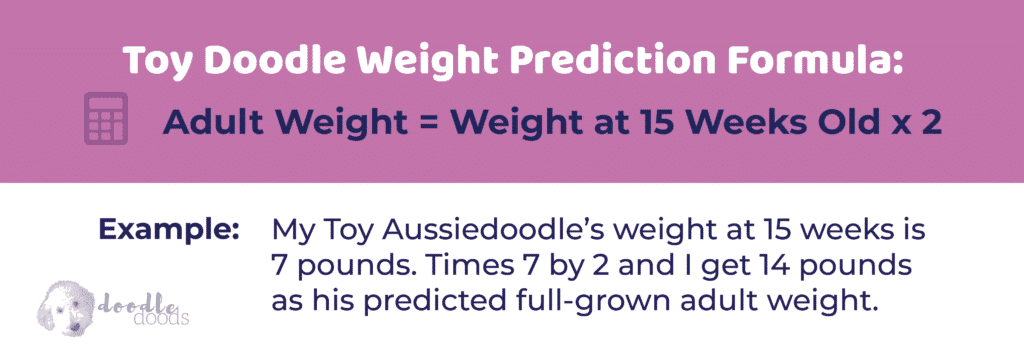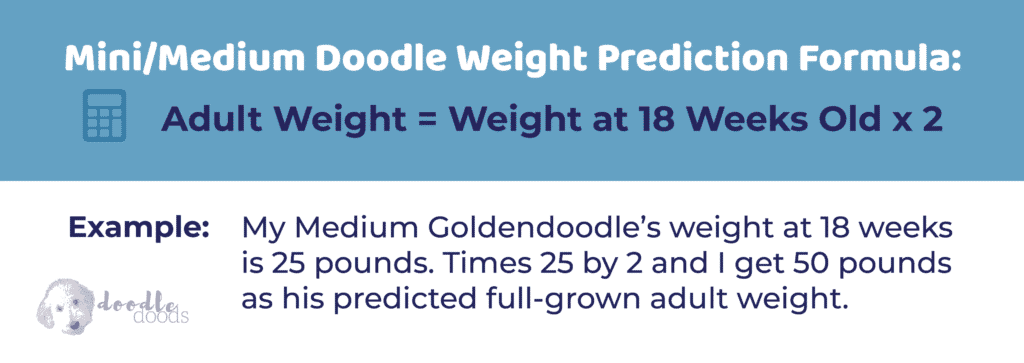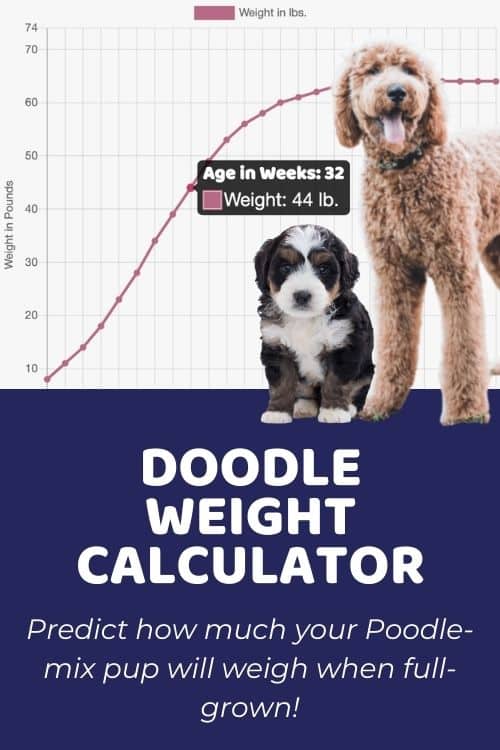Have a new Doodle puppy? Between the training, sleep deprivation, chewed up shoes and socks, there’s a big question that’s been in the back of your mind. And that is: “how big will my puppy get?” Join the club! You’re not the first person to wonder, and you won’t be the last.
Unfortunately, it is not easy to predict the exact adult size a Doodle will be when it is full-grown. This is because a Doodle is a mixed breed and its genes are not going to be as easily predicted as a purebred’s would. There are also a lot of factors that play into a Doodle’s size.
“How Big Will My Puppy Get?” – Predicting Size by Doodle Breed
All Doodles have one thing in common: Poodle. But that doesn’t mean they will all share the same genetic predictabilities. Especially when the puppy’s generation is taken into consideration. More on generations and predictability below.
To view your Doodle’s specific size guide, check out these related articles.
Generations and Predictability
One factor many people forget is that the generation of a Doodle can also play a big part in how large or small it will be when full-grown.
F1 Doodles
For instance, if you have an F1 Doodle, it will be relatively easy to predict the final adult size of your puppy. This is because an F1 Doodle has two purebred parents. Purebreds typically have very little variation in size over each generation, which means their size and growth expectations stay very consistent overtime.
F1B Doodles
If you have an F1B Doodle, theoretically much of the predictability comes back into the picture. This is to say that it may be easier to predict size and weight of an F1B than an F1 Doodle. This is because the F1B is a back-cross, making it 25% Doodle and 75% Poodle or Golden Retriever. That 75% genetic makeup is what makes the predictability easier for an F1B Doodle.
Of course, accurate predictability also depends on what size the F1B’s parents were. For example, a Toy Poodle and a Golden Retriever are crossed to create a litter of F1 Mini Goldendoodles. One of the F1 Mini Goldendoodles is then bred to a Standard Poodle to create F1B Medium Goldendoodles.
F2 and Multigen Doodles
Now, the more “Doodle” a dog is (F2 and up), the more difficult it is to predict really anything about the dog – let alone its adult size. This is because F2 Doodles are very genetically diverse.
Now, we can look solely at the general sizing charts for our puppy’s Doodle breed and decide to be happy about that “how big will my puppy get?” question. But when they say a Standard Labradoodle can weigh between 50 and 90 lb., that doesn’t give much info. And I don’t know about you, but seeing a weight range that large would still have that question burning a hole through my brain.
Puppy Growth Patterns by Size
Luckily, there are some observed patterns in the way that puppies grow in general, and we can look at those patterns to get a pretty good idea of how an individual Doodle will turn out as an adult. We can make good estimations based on the Doodle’s parents and whether the puppy is classified as a “Toy”, “Mini”, “Medium”, or “Standard” Doodle.
In fact, we created our interactive Doodle puppy growth chart and calculator based on a study that collected data on puppy growth rates based on the size of the dog.
Toy Doodles
In the study, “small” dogs weighed between 5 and 15 lb. Because this weight range is typically associated with Toy Doodles, we estimate that Toy Doodles generally reach half their adult weight at around 3.5 months old. A Toy Doodle will then reach its full adult weight between 7.5 and 11 months old.
Mini and Medium Doodles
The study classified “medium” dogs as those weighing between 15 and 55 lb. Because this weight range is associated with both Mini and Medium Doodles, we can estimate that they generally reach half their adult weight between 3.5 and 5 months old. They will then reach their full adult weight between 11 and 13 months old.
Standard Doodles
Finally, the study classified dogs weighing between 55 and 85 lb. as “large”, which is a weight range associated with Standard size Doodles. Based on the study, we can estimate that a Standard Doodle will reach half its adult weight between 4.5 and 6 months old. It will then reach its adult weight between 12.5 and 16 months old.
Quick Formulas to Predict How Big Will My Puppy Get
If you want to do a quick calculation, here are the formulas you would use to predict “how big will my puppy get” for each size of Doodle.
For Toy Doodles, use their weight at 15 weeks old for the most accuracy at predicting their adult size.

For Mini and Medium Doodles, use their weight at 18 weeks old for the most accuracy at predicting their adult size.

For Standard Doodles, use their weight at 23 weeks old for the most accuracy at predicting their adult size.

If your puppy hasn’t yet reached that age, or if you don’t have the weight recorded from when your puppy was that age, be sure to visit our interactive puppy growth chart and calculator where you can input its current age in weeks and its current weight to get a really accurate estimation!
Hopefully now you can finally put the question of “how big will my puppy get?” out of your mind.
Let us know in the comments below what your predictions are!
Learn How to Care for Your Doodle Puppy!

Perfect for first-time Doodle parents, get ALL your questions answered, including questions new Doodle parents don’t even think to ask.
Plus, get $700 worth of Bonus Materials for FREE, including:- Doodle Parenthood Community and Support Group ($190 value)
- Doodle Puppy Growth Tracker ($20 value)
- EMERGENCY Cheatsheet: When To Call The Vet Immediately ($50 value)
- HELP! Button ($145 value)
- And SO MUCH MORE!
The information on this page is for informational purposes only. It is not intended to be a substitute for qualified professional veterinary advice, diagnosis, or treatment. Always seek the advice of your veterinarian or other qualified animal health provider with any questions you may have.



